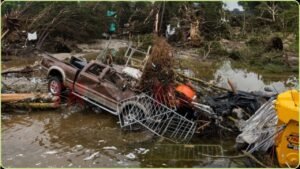Texas Flood Disaster 2025: Central Texas faces a deadly flood crisis, with 109 deaths and ongoing rescue efforts after torrential rains hit Kerr County. Explore the challenges, heroism, and questions surrounding the response to this catastrophic disaster.

Central Texas is grappling with one of its deadliest natural disasters in decades, as catastrophic flash flooding triggered by torrential rains on July 4, 2025, has claimed at least 109 lives, with dozens still missing. The tragedy, centered in Kerr County’s “Flash Flood Alley,” has devastated communities, particularly at Camp Mystic, a Christian summer camp for girls along the Guadalupe River, where at least 27 campers and counselors perished.
As rescue and recovery efforts continue under the threat of more heavy rain, questions are mounting about the adequacy of warning systems, the impact of federal funding cuts, and the handling of the disaster response. With over 850 people rescued and more than 1,750 responders deployed, Texas is mobilizing a massive operation to find survivors and support grieving families, while the looming specter of additional storms threatens to complicate an already treacherous mission.
A Catastrophic Deluge and Its Human Toll
The flooding, fueled by 5 to 11 inches of rain falling in just hours, transformed the Guadalupe River into a deadly force, surging up to 26 feet in 45 minutes in some areas. Kerr County, northwest of San Antonio, bore the brunt, with at least 87 deaths, including 30 children, reported by July 8, 2025.
The most heart-wrenching losses occurred at Camp Mystic in Hunt, Texas, where 750 girls were celebrating the Fourth of July weekend. A “pitch-black wall of death,” as one witness described the floodwaters, swept through the camp, killing at least 27 campers and counselors, with five campers and one counselor still unaccounted for, according to Kerr County Sheriff Larry Leitha.
The disaster’s scale extends beyond Kerr County, with fatalities reported in Travis (7), Burnet (5), Williamson (3), Tom Green (1), and Kendall (2) counties, pushing the total death toll to at least 109, with 161 people still missing in Kerr County alone. The Guadalupe River’s rapid rise, recorded at 29.5 feet in Hunt before gauges failed, overwhelmed homes, businesses, and infrastructure, leaving behind a trail of debris—furniture, vehicles, and personal belongings scattered across the Texas Hill Country.
Survivors like Erin Burgess, who clung to a tree with her son as floodwaters tore through her home, shared harrowing tales of survival, while others, like Javier Torres, 24, searched through mud for loved ones, recovering the bodies of his grandparents and two children.
The floods, exacerbated by a mesoscale convective complex fed by the remnants of Tropical Storm Barry and a preceding extreme drought, caught communities off guard. The parched soil, unable to absorb the deluge, funneled water into rivers, creating what the National Weather Service (NWS) called a “flood wave.”
The region, known as “Flash Flood Alley” due to its hilly terrain and susceptibility to rapid runoff, saw rainfall intensities exceeding 4 inches per hour, a once-in-500-year event for Kerrville. The economic toll is staggering, with AccuWeather estimating damages between $18 billion and $22 billion, impacting homes, schools, roads, and businesses.
Rescue and Recovery: A Race Against Time and Weather
Rescue and recovery efforts, described as one of the largest in Texas history, involve over 1,750 personnel from more than 20 local, state, and federal agencies, including the Texas National Guard, U.S. Coast Guard, and Federal Emergency Management Agency (FEMA). As of July 8, over 850 people have been rescued, with 237 airlifted, including children from Camp Mystic.
Texas Game Wardens, deploying 158 wardens, 37 boats, two helicopters, and 16 drones, have been pivotal, with one warden, Scott Ruskan, credited with rescuing 165 people. The Coast Guard’s use of MH-65 Dolphin helicopters and fixed-wing aircraft with thermal cameras has aided nighttime searches, while the Texas National Guard’s MQ-9 Reaper drone provides aerial surveillance.
However, the terrain—littered with fallen trees, furniture, and vehicles—poses significant challenges. Lt. Col. Ben Baker of the Texas Game Wardens called the conditions “extremely treacherous,” with debris piles making recovery “hazardous and time-consuming.” Mud, water, and snakes complicate ground searches, while a private drone’s collision with a rescue helicopter on July 7 forced an emergency landing, highlighting risks from unauthorized interference.
With more heavy rain forecast through July 8, potentially raising the Guadalupe River by one to two feet, aerial and ground operations face further disruption. Baker emphasized that while weather may alter patrol patterns, it “won’t deter” responders, who remain focused on finding survivors, though no live rescues have occurred since Friday, July 4.
The emotional toll on responders is profound, particularly as they recover children’s bodies. Baker noted special attention to first responders’ mental health, with crisis counselors and FBI victim support specialists deployed to aid both rescuers and families. Reunification centers, supported by the Red Cross, have been established in Kerrville and Ingram, helping families like Serena Hanor Aldrich reconnect with their children, though many still await news of missing loved ones. The Texas Rangers are collecting DNA to identify unidentified victims, with samples processed at the University of North Texas to provide closure.
Federal and State Response: Aid Amid Controversy
President Donald Trump, who signed a major disaster declaration on July 6, unlocking federal funds, announced plans to visit Texas with First Lady Melania Trump on July 11. During a July 8 Cabinet meeting, Trump praised the rapid deployment of helicopters, crediting his ties with Governor Greg Abbott for enhancing the response. The declaration activated FEMA, which is streamlining aid delivery under Homeland Security Secretary Kristi Noem, who visited Camp Mystic and emphasized saving lives as the priority.
However, Trump’s earlier stance on reducing federal disaster relief, coupled with proposed cuts to FEMA and the National Oceanic and Atmospheric Administration (NOAA), has drawn scrutiny. Critics, including climate experts, argue that staffing shortages at NWS offices in San Angelo and Austin/San Antonio—missing key roles like meteorologist-in-charge and warning coordination officer—hampered flood predictions and warnings.
Governor Abbott, who expanded the state’s disaster declaration to include Bexar, Burnet, Caldwell, Guadalupe, Travis, and Williamson counties, vowed to search for every missing person, stating, “We will not stop until every last person is accounted for.”
The Texas State Operations Center remains at Level II (Escalated Response), coordinating over 975 vehicles, including swiftwater rescue boats, Blackhawk helicopters, and K-9 units. Community efforts have also surged, with the NFL Foundation, Dallas Cowboys, and Houston Texans donating $1.5 million for relief, and locals like Alma Garcia and Perla providing food and clothing to survivors.
Questions Over Preparedness and Warning Systems
The disaster has sparked intense debate over Kerr County’s preparedness, particularly at Camp Mystic, where inspectors approved the camp’s emergency plans just two days before the floods. Despite NWS issuing flood watches and warnings, including a “catastrophic” flash flood emergency at 4:15 a.m. on July 4, many residents, like those in Bumble Bee Hills, reported receiving no timely alerts.
Kerr County Judge Rob Kelly admitted, “No one knew this kind of flood was coming,” citing the lack of a county-wide warning system due to costs. A 2017 proposal for flood sirens along the Guadalupe River never materialized, and the absence of NOAA weather radios or Starlink connectivity left some areas vulnerable.
The NWS’s San Angelo office warned of heavy rain at 1:18 p.m. on July 3, but forecasts underestimated the 10-inch deluge, which experts attribute to the climate crisis amplifying rainfall intensity. Shel Winkley of Climate Central noted that Kerr County’s extreme drought since May 2025 exacerbated runoff, while Tom Di Liberto highlighted NWS staffing shortages as a factor in delayed communication.
In contrast, nearby Comfort in Kendall County executed successful evacuations, raising questions about Kerr County’s response. Camp Mystic’s location in a FEMA-designated “special flood hazard area” has also drawn scrutiny, with critics questioning why 750 campers were not evacuated despite known risks.
Community Resilience and a Path Forward
As drier weather is forecast from July 9, recovery efforts are gaining momentum, with residents like Kathy Perkins salvaging belongings from flood-ravaged homes and others finding refuge in Red Cross shelters. The Community Foundation of the Texas Hill Country and OneStar Foundation are collecting donations, while Airbnb.org provides temporary housing for responders and displaced families. Stories of heroism, like teenage counselors shepherding campers to safety and US Coast Guard swimmer Scott Ruskan’s rescues, offer glimmers of hope amid the tragedy.
The Texas floods of 2025, already among the deadliest since Hurricane Katrina, underscore the growing threat of climate-driven disasters. With more rain possible, officials urge residents to monitor NOAA weather radios and FEMA alerts to stay safe.
As the state mourns, particularly for the children lost at Camp Mystic, the focus remains on finding the missing and rebuilding shattered communities. Governor Abbott’s pledge to leave no one behind reflects Texas’ resolve, but the disaster’s scars—both physical and emotional—will linger, prompting calls for better warning systems and climate resilience to prevent future tragedies.









